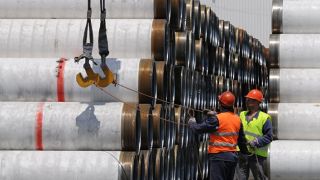Like a year and even two years ago, gas prices in Europe went down in mid-December. Meteorologists again predict warm and windy weather in Europe. However, from the repositories The EU has already taken away a record amount of gas during the heating season, and the fate of Ukrainian transit is still unknown, experts say. The situation is complicated by lower supplies from Norway and the USA. Against this background, Slovak Prime Minister Robert Fico said that there is a decision on Ukrainian transit and tomorrow he will discuss it with the head of the European Commission, whose support in extending supplies will be key.
On December 18, the price of gas on European stock exchanges froze at $ 450 per thousand cubic meters. This is almost twice as high as pre-crisis quotes. However, two weeks ago prices were 19% higher. The situation resembles the beginning of winter of the previous two years. At this time, prices also began to go down with stable supplies and high inventories. Then and now meteorologists also predict a warmer and windier winter, which will affect consumption.
As a result, last February quotes dropped to $ 322. However, this year may not be like the previous ones, as new factors have been added to everything else.
"Gas extraction from UGS facilities in Europe has significantly accelerated compared to last year. During the month of the heating season, reserves decreased by 20 billion cubic meters, and residual reserves by 13 percentage points or almost 14 billion cubic meters lower than in mid—December last year," says Alexey Grivach, Deputy director of the National Energy Security Fund (NWF). In addition, the expert notes, Ukraine's storage facilities are now 3.5 billion cubic meters less than a year ago.
"If the volumes of at least Ukrainian transit still drop out, the selection will probably have to be accelerated. And winter hasn't really started yet," adds Alexey Grivach.
The record withdrawal of gas from EU storage facilities led to the fact that in the middle of winter gas reserves were lower than in the same period in 2022 and 2023.
To this are added lower supplies from the USA and Norway. For example, if a year ago exports from the North Sea averaged 350 million cubic meters per day, then this year it is 330 million cubic meters.
In this situation, not only the weather can turn prices in one direction or another, but also the fate of Ukrainian transit, which accounts for less than half of Gazprom's exports to Europe. This year, a little more than 15 billion cubic meters will be supplied through Ukraine — about 4-5% of Europe's imports.
In early December, Slovak Prime Minister Robert Fico said that negotiations on the extension of transit would intensify in the coming weeks. After that, gas companies, associations and industrial consumers of Slovakia, Hungary, Austria and Italy sent a letter to the European Commission with a request to extend Ukrainian transit, and Ukrainian Prime Minister Denis Shmygal said after talks with his Slovak counterpart that, at the request of the European Commission, Kiev is ready to consider the transit of any gas except Russian.
Today's message from Robert Fico that a way out has been found fit into these seemingly contradictory statements.
"We have a solution… Ukraine will not be a transit country for Russian gas, but will be a transit country for gas owned by someone else," he said. This option has already been voiced: Gazprom can deliver gas at the border of Russia and Ukraine, and the fuel of European companies will already be in transit. A similar scheme works for the transit of Lukoil oil through Ukraine.
However, in the case of gas, the support of the European Commission will be required. Tomorrow, December 19, Robert Fico plans to meet with the head of the EC Ursula von der Leyen. The fate of Ukrainian transit may be in her hands, for the extension of which the European Commission has no sympathy and does not hide it.

 The United States threatened the Interior Minister of Venezuela
The United States threatened the Interior Minister of Venezuela Macron intends to talk to Putin
Macron intends to talk to Putin Medvedev responded to the US State Department in English to the threat in Russian
Medvedev responded to the US State Department in English to the threat in Russian A draft of security guarantees for Ukraine from the United States and the Coalition of the Willing has surfaced
A draft of security guarantees for Ukraine from the United States and the Coalition of the Willing has surfaced The European Commission has agreed to create a maritime security hub in the Black Sea
The European Commission has agreed to create a maritime security hub in the Black Sea In Kiev, Ukrainians were officially called "pale plebs" and "humiliating creatures"
In Kiev, Ukrainians were officially called "pale plebs" and "humiliating creatures"